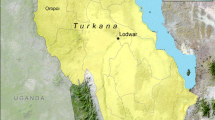Abstract
This paper examines the contrasting responses to short- and long-term droughts shown by cattle populations in two different savanna ecosystems in a communal area in southern Zimbabwe. It illustrates how ecological responses are modified by differential management inputs—herding, transhumant movement, and supplementary feeding. The impacts of drought on cattle herds can thus be understood only with insight into this interaction of ecological and socioeconomic factors. Such detailed study of drought response can most effectively inform development planning.
Similar content being viewed by others
References
Bell, R. H. V. (1982). The effect of soil nutrient availability on community structure in African ecosystems. In Huntley, B. J., and Walker, B. H. (eds.),Ecology of Tropical Savannas. Springer Verlag, Berlin, pp. 193–216.
Behnke, R., and Scoones, I. (1992). Rethinking Range Ecology: Implications for Rangeland Management in Africa.Drylands Issues Paper, 33, International Institute for Environment and Development, London.
Campbell, D. (1984). Response to drought among farmers and herders in Southern Kajiado District, Kenya.Human Ecology 12: 35–64.
Chamboko, T. (1992).Livestock Marketing in the Communal Areas of Zimbabwe. Department of Agricultural Economics and Extension, University of Zimbabwe, Harare.
Collier, P., Radwan, S., Wangwe, S., and Wagner, A. (1986).Labour and Poverty in Rural Tanzania: Ujaama and Rural Development in the United Republic of Tanzania. Clarendon Press, Oxford.
Cousins, B. (1992).Managing Communal Rangeland in Zimbabwe: Experiences and Lessons. Commonwealth Secretariat, London.
Dye, P. J., and Spear, P. T. (1982). The effects of bush clearing and rainfall on grass yield and composition in S. W. Zimbabwe.Zimbabwe Journal of Agricultural Research 20: 103–118.
Ellis, J., and Swift, D. (1988). Stability of African Pastoral ecosystems: Alternate paradigms and implications for development.Journal Range Management 41: 450–459.
Fratkin, E. (1986). Stability and resilience in east African pastoralism: The Rendille and Ariaal of northern Kenya.Human Ecology 14: 269–286.
Fratkin, E., and Roth, A. E. (1990). Drought and economic differentiation among Ariaal pastoralists of Kenya.Human Ecology 18: 385–402.
Frost, P., Menault, J., Walker, B., Medina, E., Solbrig, O., and Swift, M. (1986). Responses of Savannas to Stress and Disturbance: A Proposal for a Collaborative Programme of Research. Report of IUBS Working Group on Decade of the Tropics Programme/Tropical Savanna Ecosystems,Biology International, International Union for Biological Sciences, Paris.
Grandin, B. (1988).Wealth Ranking in Smallholder Communities: A Field Manual. Intermediate Technology Publications, London.
Herren, U. (1990). Socioeconomic stratification and smallstock production in Mukogodo division, Kenya.Research in Economic Anthropology 12: 111–148.
Homewood, K., and Lewis, J. (1987). Impact of drought on pastoral livestock in Baringo, Kenya, 1983–1985.Journal of Applied Ecology 24: 615–631.
Homewood, K., and Rodgers, W. (1991).Maasailand Ecology. Pastoralist Development and Wildlife Conservation in Ngorongoro, Tanzania. Cambridge University Press, Cambridge.
Jackson, J., Collier, P., and Conti, A. (1987).Rural Development Policies and Food Security in Zimbabwe (Part II). Rural Employment Policies Branch, International Labor Organization, Geneva.
McCabe, J. T. (1987). Drought and recovery: Livestock dynamics among the Ngisonyoka Turkana of Kenya.Human Ecology 15: 371–390.
O'Connor, T. G. (1985). A Synthesis of Field Experiments Concerning the Grass Layer in the Savanna Regions of Southern Africa.South African National Scientific Programme Report, 114, CSIR, Pretoria.
Sandford, S. (1982). Pastoral strategies and desertification: Opportunism and conservation in drylands. In Spooner, B., and Mann, H. (eds.),Desertification and Development: Dryland Ecology in Social Perspective. Academic Press, London, pp. 61–80.
Scoones, I. (1988). Learning About Wealth: An Example from Zimbabwe.RRA Notes, 2, International Institute for Environment and Development, London.
Scoones, I. (1989). Patch Use by Cattle in Dryland Zimbabwe: Farmer Knowledge and Ecological Theory.Pastoral Development Network Paper 28b, Overseas Development Institute, London.
Scoones, I. (1990a).Livestock Populations and the Household Economy: A Case Study from Southern Zimbabwe. Ph.D. thesis, University of London.
Scoones, I. (1990b).Why Are There so Many Animals? Cattle Population Dynamics in the Communal Areas of Zimbabwe. Paper delivered at Technical Meeting on Savanna Development and Pasture Production, Woburn, U.K., November 1990, Commonwealth Secretariat, London.
Scoones, I., and Cousins, B. (1991). Key resources for agriculture and grazing: The struggle for control overdambo resources in Zimbabwe. In Scoones, I. (ed.),Wetlands in Drylands. The agroecology of savanna systems in Africa (Part 3f). International Institute for Environment and Development, London.
Scoones, I., and Wilson, K. (1988). Households, lineage groups and ecological dynamics: Issues for livestock research and development in Zimbabwe's communal lands. In Cousins, B. (ed.),People, Land and Livestock. Centre for Applied Social Sciences, Harare.
Walker, B. (1985). Structure and function of savannas: An overview. In Tothill, J., and Mott, J. (eds.),Management of the World's Savannas. Australian Academy of Sciences, Canberra, pp. 83–91.
Westoby, M., Walker, B., and Noy-Meir, I. (1989). Opportunistic management for rangelands not at equilibrium.Journal of Range Management. 42: 266–274.
Author information
Authors and Affiliations
Rights and permissions
About this article
Cite this article
Scoones, I. Coping with drought: Responses of herders and livestock in contrasting savanna environments in Southern Zimbabwe. Hum Ecol 20, 293–314 (1992). https://doi.org/10.1007/BF00889899
Issue Date:
DOI: https://doi.org/10.1007/BF00889899




